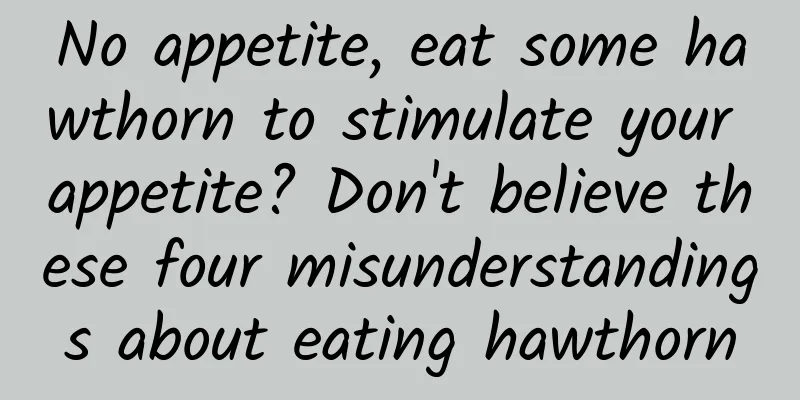No appetite, eat some hawthorn to stimulate your appetite? Don't believe these four misunderstandings about eating hawthorn

|
In this cold winter, holding a string of candied haws in hand and enjoying its sweet and sour taste, I'm sure many people have experienced this comfort. As the main ingredient of candied haws, hawthorn is rich in various nutrients and has the benefits of appetizing and promoting digestion. However, in many people's stereotypes, there are still some misunderstandings about eating hawthorn. Hawthorn is rich in nutritional value Hawthorn is a specialty fruit tree in my country. It is a plant of the genus Crataegus in the subfamily Apple of the Rosaceae family. It is widely distributed in Asia, Europe, North America and South America. Hawthorn is mainly produced in the north of my country and is also planted in the south. It has a long history of edible and medicinal value. Hawthorn, also known as mountain red and red fruit, belongs to the same pome fruit as apple, pear and crabapple. It is often processed into foods such as candied haws, fruit danpi, canned hawthorn, hawthorn cake, hawthorn slices, and hawthorn drinks. The nutritional value of hawthorn includes the following aspects: Rich in flavonoids. Hawthorn contains more flavonoids such as flavonols and catechins, and has strong antioxidant capacity. High in vitamin C. According to the "Standard Edition of Chinese Food Composition Table (Sixth Edition)", the vitamin C content of hawthorn is 53 mg per 100 grams, which is higher than that of citrus, lemon, apple and orange. Another study determined that the average vitamin C content of fresh hawthorn fruit in 7 regions is 81.2 mg/100 grams. Eating 100 grams (about 10 pieces) of hawthorn can meet 80% of the daily recommended amount of vitamin C for adults. Rich in pectin. The pectin content in hawthorn is as high as 2%, which ranks among the top fruits. If you cook a pot of hawthorn soup, add a proper amount of sugar to adjust the sweetness and sourness, and then put it in the refrigerator to cool, you will find that it has solidified into jelly. The formation of this jelly is precisely because of the rich pectin in it. The benefit of pectin is that it can effectively slow down the rise of blood sugar and blood lipids after meals, and it also has a positive effect on intestinal health. Contains a variety of organic acids. The main organic acid in hawthorn is citric acid, followed by malic acid, while the content of astringent components such as tartaric acid and oxalic acid is very low. Hawthorn has a high acidity, with a pH value of less than 2.8, which is even sourer than ordinary vinegar. Due to the low sugar content and low sugar-acid ratio, the taste of hawthorn is almost entirely sour. Because of the role of organic acids, it can stimulate the secretion of digestive juices and promote intestinal peristalsis, so hawthorn does help to stimulate appetite and digestion to a certain extent. Other nutrients: Hawthorn contains more beta-carotene, which helps protect eye health. Hawthorn also has a good potassium content. Many studies have confirmed that potassium supplementation can lower blood pressure in patients with hypertension. Eating misunderstandings should be eliminated Misconception 1: Eating hawthorn can supplement iron. This is what is called "replenishing color with color". Hawthorn is not the best choice for iron supplementation. Hawthorn contains very little iron, and even if it does contain a little, it is non-heme iron, and the absorption rate is not high. However, the vitamin C it contains can promote iron absorption. If you want to supplement iron, you also need to choose foods such as animal blood, animal liver, and lean meat that are not only high in iron but also have a good absorption rate. Myth 2: You can’t eat hawthorn when you are pregnant. In some areas, there is a saying that "you can't eat hawthorn during pregnancy, otherwise it will cause uterine contractions and lead to miscarriage." There is not enough scientific evidence to support this statement. Hawthorn can be eaten in moderation during pregnancy. Unless there are gastrointestinal health problems, it may cause acid reflux and other conditions. Misconception 3: Hawthorn snacks such as hawthorn strips and hawthorn sticks can stimulate appetite. The truth is that it can't. Because the sugar-acid ratio of hawthorn itself is too low, merchants add a lot of sugar or sugar substitutes to make candied haws, hawthorn slices, hawthorn jam, hawthorn cakes, etc., so that people can eat them more easily. But if you count on these hawthorn snacks to whet your appetite, it is easy to consume too much sugar. For example, a certain hawthorn slice on the market has a sugar content of about 60 grams per 100 grams. According to the "Dietary Guidelines for Chinese Residents (2022 Edition)", it is recommended that the daily intake of added sugar should not exceed 50 grams, and it is best to control it below 25 grams. If too much sugar is consumed, children are prone to tooth decay, and adults may have a heavier taste, and the risk of obesity will increase due to excessive energy intake. Misconception 4: Eating hawthorn and chestnuts together will cause stomach stones. There is no sufficient evidence to show that eating hawthorn and chestnut together will cause gastric stones in healthy people, but eating them in moderation is fine. Some people believe that "hawthorn contains tannic acid, and chestnuts contain a lot of dietary fiber and starch, and eating them together will cause gastric stones." In fact, this type of gastric stones usually occurs in people with gastric diseases such as gastritis, gastric ulcers, and post-gastric surgery. These people are prone to acid reflux, and eating foods with high tannic acid content can easily increase the risk of gastric stones. The tannic acid content of hawthorn on the market is generally very low, and healthy people will not develop gastric stones by eating hawthorn and chestnuts. However, due to the high tannic acid content of immature hawthorn, eating too much may cause abdominal distension and abdominal pain, so you still need to pay attention to the moderation. In short, it is best to avoid eating hawthorn on an empty stomach or for a long time. People with gastritis or gastric ulcers who want to eat hawthorn should eat one or two at a time. As for hawthorn slices, hawthorn cakes, fruit danpi and other processed foods, since they contain a lot of sugar, they can only be eaten occasionally to satisfy their cravings. (The author Wang Yanli is a member of the China Science Writers Association and a registered nutritionist) |
<<: The Year of the Snake is here. Let’s talk about why we are naturally afraid of snakes.
>>: The New Year is coming soon. How do mothers do their hair?
Recommend
What are the optimization tips for Toutiao information flow ads? Here is the methodology!
There is too little exposure, why is there no sal...
From Darwin, Mendel to Watson, why do these great scientists want to know the genetic secrets of life?
Introduction Throughout history, there have been ...
The Ideal Car broke down after nine days and could not be returned or exchanged due to lagging regulations. How could users be allowed to swallow this bitter fruit?
On July 7, the 1818 Golden Eye program reported t...
Instructions | What is the difference between the space supplies used by astronauts and those we use?
The astronauts of Shenzhou-15 stayed in the space...
(Big Soldier Data Flow Operation) Dou+ Doujia Practical Tutorial
(Big Soldier Data Flow Operation) Dou+ Doujia Pra...
The "plot bug" in episode 41 of "The Legend of Zhen Huan" actually hides a little-known fact that many people don't know!
"Wake up, it's time to take tranquilizer...
Chaohu Mini Program Production Company, how much does it cost to make a luggage mini program?
How much does it cost to produce the Chaohu lugga...
Sony selflessly contributes LDAC: Android O wireless sound quality explodes
Earlier, there were rumors that Google's next-...
Olympic ratings plummet: Will NBC's tragedy happen again in China four years later?
With the official end of the Olympic Games on Aug...
Android BLE Bluetooth development, connect Bluetooth devices for communication
1. Introduction This article is mainly based on A...
Long article with useful information | This article teaches you how to write popular user cases!
User cases are common promotional materials, and ...
Android source code download: Bluetooth_4.3 BLE Bluetooth communication
Functional classification: Tools Supported platfo...
Useful post! Compiled from 22 copyright-free, free, high-definition picture material websites!
There is no doubt that picture materials are beco...
New media traffic A-goods high-imitation product routines to make money quickly and achieve a monthly income of 100,000+ (video tutorial)
New media traffic A-goods high-imitation product ...
Does breathing through the mouth really ruin your appearance?
We need to breathe every moment, but have you eve...









